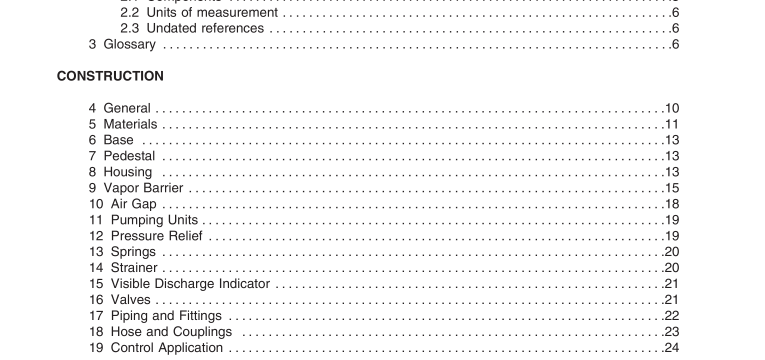UL 87-2019 pdf download.Power-Operated Dispensing Devices for Petroleum Products.
1 Scope 1.1 These requirements apply to power-operated dispensing devices for petroleum products such as gasoline for use as motor fuel. Requirements for the installation and use of these dispensing devices are included in the Automotive and Marine Service Station Code, NFPA 30A, and the National Electrical Code, NFPA 70. 1.2 These requirements apply to wiring methods used to install or interconnect such control equipment when the equipment is located directly on or within the housing of the dispensing device. These requirements do not apply to control equipment that may authorize, monitor, or interrupt operation of a power-operated dispensing device. Such equipment includes panel mounted equipment located adjacent to the dispensing device, remote consoles located inside a permanent structure, and auxiliary equipment physically attached to the dispensing device or enclosed by the pedestal and housing. 2 General 2.1 Components 2.1.1 Except as indicated in 2.1.2, a component of a product covered by this standard shall comply with the requirements for that component. See Appendix A for a list of typical standards covering components used in the products covered by this standard. 2.1.2 A component is not required to comply with a specific requirement that: a) Involves a feature or characteristic not required in the application of the component in the product covered by this standard, or b) Is superseded by a requirement in this standard. 2.1.3 A component shall be used in accordance with its rating established for the intended conditions of use. 2.1 .4 Specific components are incomplete in construction features or restricted in performance capabilities. Such components are intended for use only under limited conditions, such as certain temperatures not exceeding specified limits, and shall be used only under those specific conditions.
2.2 Units of measurement 2.2.1 Values stated without parentheses are the requirement. Values in parentheses are explanatory or approximate information. 2.3 Undated references 2.3.1 Any undated reference to a code or standard appearing in the requirements of this standard shall be interpreted as referring to the latest edition of that code or standard. 3 Glossary 3.1 For the purpose of this standard the following definitions apply. 3.2 AIR GAP – A minimum of 1 inch (25.4 mm) free air space provided between the planes of Division 1, Division 2, Zone 1 or Zone 2 hazardous locations and an unclassified area of a dispensing device. 3.3 BASE – That part of the assembly which is intended to be secured to the foundation on which the device will be installed. 3.4 CLASS I HAZARDOUS LOCATIONS – Locations in which flammable gases or vapors are or may be present in the air in quantities sufficient to produce explosive or ignitable mixtures. For the purpose of these requirements, as applied to dispensing systems of other than the overhead type, the following classified areas are further defined. Such areas for overhead type systems shall be as specified in the Code for Motor Fuel Dispensing Facilities and Repair Garages, NFPA 30A. The area of the dispensing system covered by these requirements is the envelope defined by the maximum outer dimensions.
3.5 DISPENSER, REMOTE-CONTROL TYPE – A dispensing device that does not contain a power-operated pump as part of the assembly, and which is intended for connection to a fluid piping system containing the power operated pumps at a remote location. Also commonly identified as a ″dispenser.″ 3.6 DISPENSER, SELF-CONTAINED – A dispensing device that includes a power operated pump as part of the assembly. Also commonly identified as a ″pump″ or ″suction dispenser.″ 3.7 DISPENSING DEVICE – A product consisting of various components as applicable, which are used to control and meter the flow of liquid from an upstream storage device. 3.8 ELECTRICAL CIRCUITS – a) High-Voltage Circuit – A circuit involving a potential of not more than 600 volts and having circuit characteristics in excess of those of a low-voltage or Class 2 circuit. b) Low-Voltage Circuit – A circuit involving a potential of not more than 30 volts alternating- current (rms) (42.4 volts peak or direct current) and 1) Supplied by a Class 2 transformer, or by a battery, by a battery and fixed impedance, or by a transformer and fixed impedance each of which, as a unit, is in compliance with what is required for a Class 2 transformer or 2) Limited to a maximum of 100 volt-amperes.UL 87-2019 pdf download.
UL 87-2019 pdf download
